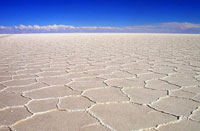Salt lakes make dinosaurs reign on Earth
Russian and German scientists set forth a new theory to explain the phenomenon of mass extinction of living creatures on planet Earth 250 million years ago. About 90 percent of marine and 70 percent of land species became extinct within a million years, which is rather fast from the geological point of view. The phenomenon led to the reign of dinosaurs on Earth some time later.

The reason of the global disaster still remains a mystery for scientists. Many theories said that the mass extinction began as a result of either volcanic activities or the fall of a large meteorite on the planet. A group of scientists from the Institute of the Physics of Atmosphere of the Russian Academy of Sciences, the Environment Research Center from Leipzig, Germany, and the Max Planck Institute for Nuclear Physics, Germany, set forth a completely different theory.
The scientists believe that the mass extinction of species was caused with the bacteria in the gigantic shallow sea of Zechstein. The bacteria, the scientists said, produced volatile halohydrocarbons.
Lidia Lisitsyna, a scientist with the Institute for the Physics of Atmosphere, told Infox.ru that halohydrocarbons were originally thought to be the by-products of the chemical industry only. However, it turns out that there is a natural source to the poisonous substance: wild fires and the activity of halophytic bacteria, which scientists discovered in 2005 in the lakes of Russia’s Kalmykia Republic and in South Africa.
The halobacteria, which inhabit salt lakes, are one of the most ancient forms of life on Earth. They conquered the whole planet very quickly due to their resistance to heat and cold. The bacteria survive the drought season (when salt lakes dry out) living between the salt crystals. They only need salt to stay alive. The bacteria die as soon as the level of fresh water begins to rise.
The halohydrocarbons, which the bacteria produce, are dangerous to the environment. Once the substance finds itself in the atmosphere, it triggers photochemical reactions, which destroy the ozone screen of the planet. The deterioration of the ozone layer of the Earth’s atmosphere could probably be the reason of the global catastrophe.
Halohydrocarbons are extremely toxic to plants. They affect the photosynthesis, accelerating the process, but intensify the evaporation from the surface of leaves. It results in the death of plants under the conditions of dry and hot climate.
Subscribe to Pravda.Ru Telegram channel, Facebook, RSS!




